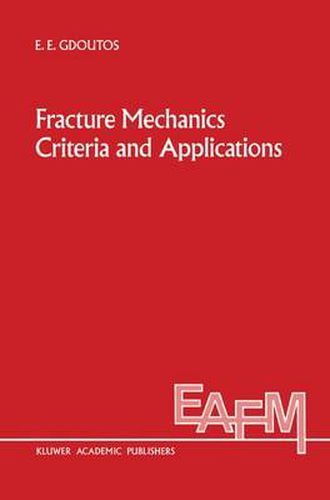Readings Newsletter
Become a Readings Member to make your shopping experience even easier.
Sign in or sign up for free!
You’re not far away from qualifying for FREE standard shipping within Australia
You’ve qualified for FREE standard shipping within Australia
The cart is loading…






This title is printed to order. This book may have been self-published. If so, we cannot guarantee the quality of the content. In the main most books will have gone through the editing process however some may not. We therefore suggest that you be aware of this before ordering this book. If in doubt check either the author or publisher’s details as we are unable to accept any returns unless they are faulty. Please contact us if you have any questions.
It is difficult to do justice to fracture mechanics in a textbook, for the subject encompasses so many disciplines. A general survey of the field would serve no purpose other than give a collection of references. The present book by Professor E. E. Gdoutos is refreshing because it does not fall into the esoteric tradition of outlining equations and results. Basic ideas and underlying principles are clearly explained as to how they are used in application. The presentations are concise and each topic can be understood by advanced undergraduates in material science and continuum mechanics. The book is highly recommended not only as a text in fracture mechanics but also as a reference to those interested in the general aspects of failure analysis. In addition to providing an in-depth review of the analytical methods for evaluating the fundamental quantities used in linear elastic fracture mechanics, various criteria are discussed re:O. ecting their limitations and applications. Par ticular emphases are given to predicting crack initiation, subcritical growth and the onset of rapid fracture from a single criterion. Those models in which it is assumed that the crack extends from tip to tip rely on the specific surface energy concept. The differences in the global and energy states before and after crack extension were associated with the energy required to create a unit area of crack surface. Applications were limited by the requirement of self-similar crack growth.
$9.00 standard shipping within Australia
FREE standard shipping within Australia for orders over $100.00
Express & International shipping calculated at checkout
This title is printed to order. This book may have been self-published. If so, we cannot guarantee the quality of the content. In the main most books will have gone through the editing process however some may not. We therefore suggest that you be aware of this before ordering this book. If in doubt check either the author or publisher’s details as we are unable to accept any returns unless they are faulty. Please contact us if you have any questions.
It is difficult to do justice to fracture mechanics in a textbook, for the subject encompasses so many disciplines. A general survey of the field would serve no purpose other than give a collection of references. The present book by Professor E. E. Gdoutos is refreshing because it does not fall into the esoteric tradition of outlining equations and results. Basic ideas and underlying principles are clearly explained as to how they are used in application. The presentations are concise and each topic can be understood by advanced undergraduates in material science and continuum mechanics. The book is highly recommended not only as a text in fracture mechanics but also as a reference to those interested in the general aspects of failure analysis. In addition to providing an in-depth review of the analytical methods for evaluating the fundamental quantities used in linear elastic fracture mechanics, various criteria are discussed re:O. ecting their limitations and applications. Par ticular emphases are given to predicting crack initiation, subcritical growth and the onset of rapid fracture from a single criterion. Those models in which it is assumed that the crack extends from tip to tip rely on the specific surface energy concept. The differences in the global and energy states before and after crack extension were associated with the energy required to create a unit area of crack surface. Applications were limited by the requirement of self-similar crack growth.